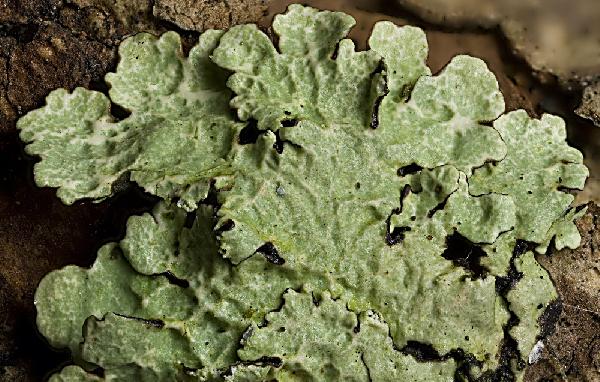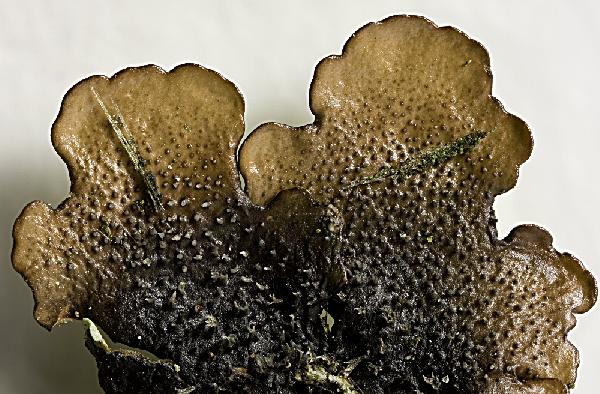Flavopunctelia flaventior (Stirt.) Hale
Mycotaxon, 20: 682, 1984. Basionym: Parmelia flaventior Stirt. - Scottish Natur., 4: 254, 1878.
Synonyms: Parmelia andreana Müll. Arg.; Parmelia kernstockii Lynge & Zahlbr.; Parmelia lobarina Zahlbr.; Parmelia variata Hue; Punctelia flaventior (Stirt.) Krog
Distribution: N - VG, Frl (Tretiach & Molaro 2007), Ven (Nascimbene & Marini 2010), TAA (Nascimbene 2005b, 2006c, 2008b, 2014, Nascimbene & al. 2007b, 2014), Lig (TSB 21799). S - Tosc (Nascimbene & al. 2015), Camp (Aprile & al. 2002, Garofalo & al. 2010).
Description: Thallus foliose, heteromerous, dorsiventral, tightly adnate to weakly appressed, forming 4-13(-20) cm wide rosettes. Lobes 2-6(-9) mm wide, flat, contiguous, greenish yellow, smooth to usually wrinkled to weakly ridged-reticulate, with white, large (to 1 mm), round to slightly elongated pseudocyphellae which give rise to round, laminal or rarely marginal, 0.5-2 mm wide soralia. Lower surface black to dark chestnut brown, paler at margin, with mostly simple, short, dark rhizines, except in the usually paler marginal zone. Upper cortex paraplectenchymatous, with a non-pored epicortex, the cell walls with an intermediate type of lichenan; medulla white; algal layer continuous; lower cortex paraplectenchymatous. Apothecia rare, lecanorine, 2-6 mm across, the disc brown, the margin pseudocyphellate and becoming sorediate. Epithecium brownish; hymenium and hypothecium colourless. Asci 8-spored. Lecanora-type. Ascospores 1-celled, hyaline, ovoid to ellipsoid, 8-13 x 5-7 µm. Pycnidia rare, black, immersed. Conidia bifusiform, 6-10 µm long. Photobiont chlorococcoid. Spot tests: cortex K+ yellowish, KC- or KC+ pale yellow, C-, P-; medulla K- C+ red, KC+ red, P-. Chemistry: cortex with usnic acid (minor) and rarely traces of atranorin; medulla with lecanoric acid (major).Note: a species of rather continental areas, found on more or less isolated deciduous trees, most frequent in dry Alpine valleys. The records from Campania (Mt. Vesuvius) are rather unusual and need re-confirmation.
Growth form: Foliose, broad lobed
Substrata: bark
Photobiont: green algae other than Trentepohlia
Reproductive strategy: mainly asexual, by soredia, or soredia-like structures (e.g. blastidia)
Subcontinental: restricted to areas with a dry-subcontinental climate (e.g. dry Alpine valleys, parts of Mediterranean Italy)
Commonnes-rarity: (info)
Alpine belt: absent
Subalpine belt: absent
Oromediterranean belt: absent
Montane belt: extremely rare
Submediterranean belt: rare
Padanian area: absent
Humid submediterranean belt: very rare
Humid mediterranean belt: absent
Dry mediterranean belt: absent

Predictive model
Herbarium samples


G. Incerti; Owner: Department of Life Sciences, University of Trieste
Herbarium: TSB (31382)
2001/11/26

Jacques Haine - Source: http://www.lichensmaritimes.org/index.php?task=fiche&lichen=868&lang=en
France, Drôme Provençale


Felix Schumm - CC BY-SA 4.0
[11989], Germany, Baden-Württemberg, Kreis Göppingen, Göppingen, an einer Pappelallee in der Blumenstraße, eutrophiert, photophytisch, 48°42.388' N, 0°40.042' E, 350 m. Leg. Schumm 26.03.2005, det. Schumm 26.03.2005.


Felix Schumm - CC BY-SA 4.0
[11989], Germany, Baden-Württemberg, Kreis Göppingen, Göppingen, an einer Pappelallee in der Blumenstraße, eutrophiert, photophytisch, 48°42.388' N, 0°40.042' E, 350 m. Leg. Schumm 26.03.2005, det. Schumm 26.03.2005.


Felix Schumm - CC BY-SA 4.0
[11989], Germany, Baden-Württemberg, Kreis Göppingen, Göppingen, an einer Pappelallee in der Blumenstraße, eutrophiert, photophytisch, 48°42.388' N, 0°40.042' E, 350 m. Leg. Schumm 26.03.2005, det. Schumm 26.03.2005.


Felix Schumm – CC BY-SA 4.0
Image from: F. Schumm (2008) - Flechten Madeiras, der Kanaren und Azoren. Beck, OHG - ISBN: 978-3-00-023700-3

Jacques Haine - Source: http://www.lichensmaritimes.org/index.php?task=fiche&lichen=868&lang=en
France, Drôme Provençale

Jacques Haine - Source: http://www.lichensmaritimes.org/index.php?task=fiche&lichen=868&lang=en
France, Drôme Provençale

Jacques Haine - Source: http://www.lichensmaritimes.org/index.php?task=fiche&lichen=868&lang=en
France, Drôme Provençale

Jacques Haine - Source: http://www.lichensmaritimes.org/index.php?task=fiche&lichen=868&lang=en
France, Drôme Provençale

Jacques Haine - Source: http://www.lichensmaritimes.org/index.php?task=fiche&lichen=868&lang=en
France, Drôme Provençale


Felix Schumm - CC BY-SA 4.0
[11989], Germany, Baden-Württemberg, Kreis Göppingen, Göppingen, an einer Pappelallee in der Blumenstraße, eutrophiert, photophytisch, 48°42.388' N, 0°40.042' E, 350 m. Leg. Schumm 26.03.2005, det. Schumm 26.03.2005.

Jacques Haine - Source: http://www.lichensmaritimes.org/index.php?task=fiche&lichen=868&lang=en
France, Drôme Provençale

Jacques Haine - Source: http://www.lichensmaritimes.org/index.php?task=fiche&lichen=868&lang=en
France, Drôme Provençale

Ulrich Kirschbaum CC BY-SA 4.0 - Source: https://www.thm.de/lse/ulrich-kirschbaum/flechtenbilder
Central Europe: Germany.
Growth form: Foliose, broad lobed
Substrata: bark
Photobiont: green algae other than Trentepohlia
Reproductive strategy: mainly asexual, by soredia, or soredia-like structures (e.g. blastidia)
Subcontinental: restricted to areas with a dry-subcontinental climate (e.g. dry Alpine valleys, parts of Mediterranean Italy)
Commonnes-rarity: (info)
Alpine belt: absent
Subalpine belt: absent
Oromediterranean belt: absent
Montane belt: extremely rare
Submediterranean belt: rare
Padanian area: absent
Humid submediterranean belt: very rare
Humid mediterranean belt: absent
Dry mediterranean belt: absent

Predictive model
| Herbarium samples |


G. Incerti; Owner: Department of Life Sciences, University of Trieste
Herbarium: TSB (31382)
2001/11/26

Jacques Haine - Source: http://www.lichensmaritimes.org/index.php?task=fiche&lichen=868&lang=en
France, Drôme Provençale


Felix Schumm - CC BY-SA 4.0
[11989], Germany, Baden-Württemberg, Kreis Göppingen, Göppingen, an einer Pappelallee in der Blumenstraße, eutrophiert, photophytisch, 48°42.388' N, 0°40.042' E, 350 m. Leg. Schumm 26.03.2005, det. Schumm 26.03.2005.


Felix Schumm - CC BY-SA 4.0
[11989], Germany, Baden-Württemberg, Kreis Göppingen, Göppingen, an einer Pappelallee in der Blumenstraße, eutrophiert, photophytisch, 48°42.388' N, 0°40.042' E, 350 m. Leg. Schumm 26.03.2005, det. Schumm 26.03.2005.


Felix Schumm - CC BY-SA 4.0
[11989], Germany, Baden-Württemberg, Kreis Göppingen, Göppingen, an einer Pappelallee in der Blumenstraße, eutrophiert, photophytisch, 48°42.388' N, 0°40.042' E, 350 m. Leg. Schumm 26.03.2005, det. Schumm 26.03.2005.


Felix Schumm – CC BY-SA 4.0
Image from: F. Schumm (2008) - Flechten Madeiras, der Kanaren und Azoren. Beck, OHG - ISBN: 978-3-00-023700-3

Jacques Haine - Source: http://www.lichensmaritimes.org/index.php?task=fiche&lichen=868&lang=en
France, Drôme Provençale

Jacques Haine - Source: http://www.lichensmaritimes.org/index.php?task=fiche&lichen=868&lang=en
France, Drôme Provençale

Jacques Haine - Source: http://www.lichensmaritimes.org/index.php?task=fiche&lichen=868&lang=en
France, Drôme Provençale

Jacques Haine - Source: http://www.lichensmaritimes.org/index.php?task=fiche&lichen=868&lang=en
France, Drôme Provençale

Jacques Haine - Source: http://www.lichensmaritimes.org/index.php?task=fiche&lichen=868&lang=en
France, Drôme Provençale


Felix Schumm - CC BY-SA 4.0
[11989], Germany, Baden-Württemberg, Kreis Göppingen, Göppingen, an einer Pappelallee in der Blumenstraße, eutrophiert, photophytisch, 48°42.388' N, 0°40.042' E, 350 m. Leg. Schumm 26.03.2005, det. Schumm 26.03.2005.

Jacques Haine - Source: http://www.lichensmaritimes.org/index.php?task=fiche&lichen=868&lang=en
France, Drôme Provençale

Jacques Haine - Source: http://www.lichensmaritimes.org/index.php?task=fiche&lichen=868&lang=en
France, Drôme Provençale

 INDEX FUNGORUM
INDEX FUNGORUM
 GBIF
GBIF
 DOLICHENS
DOLICHENS



